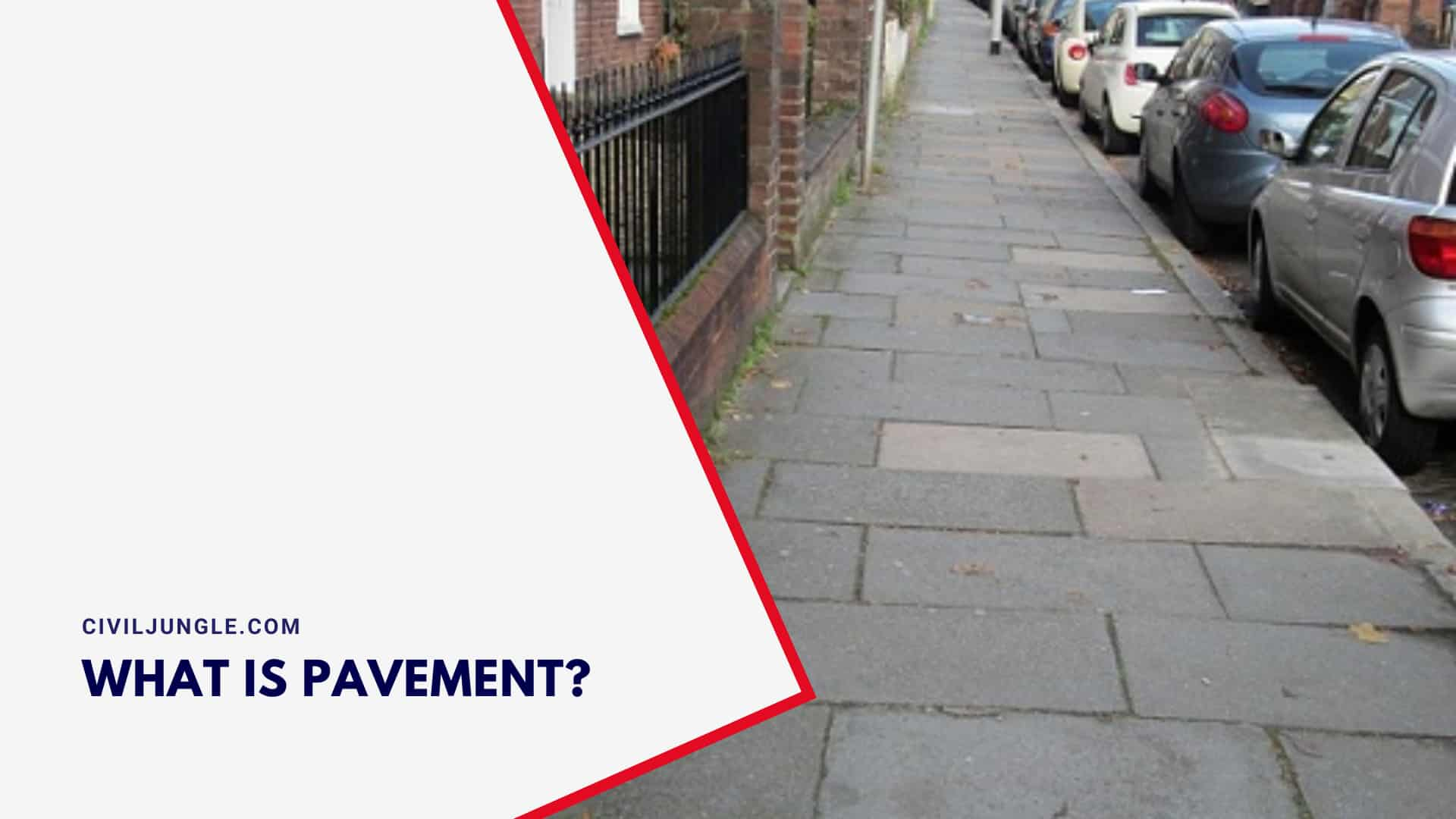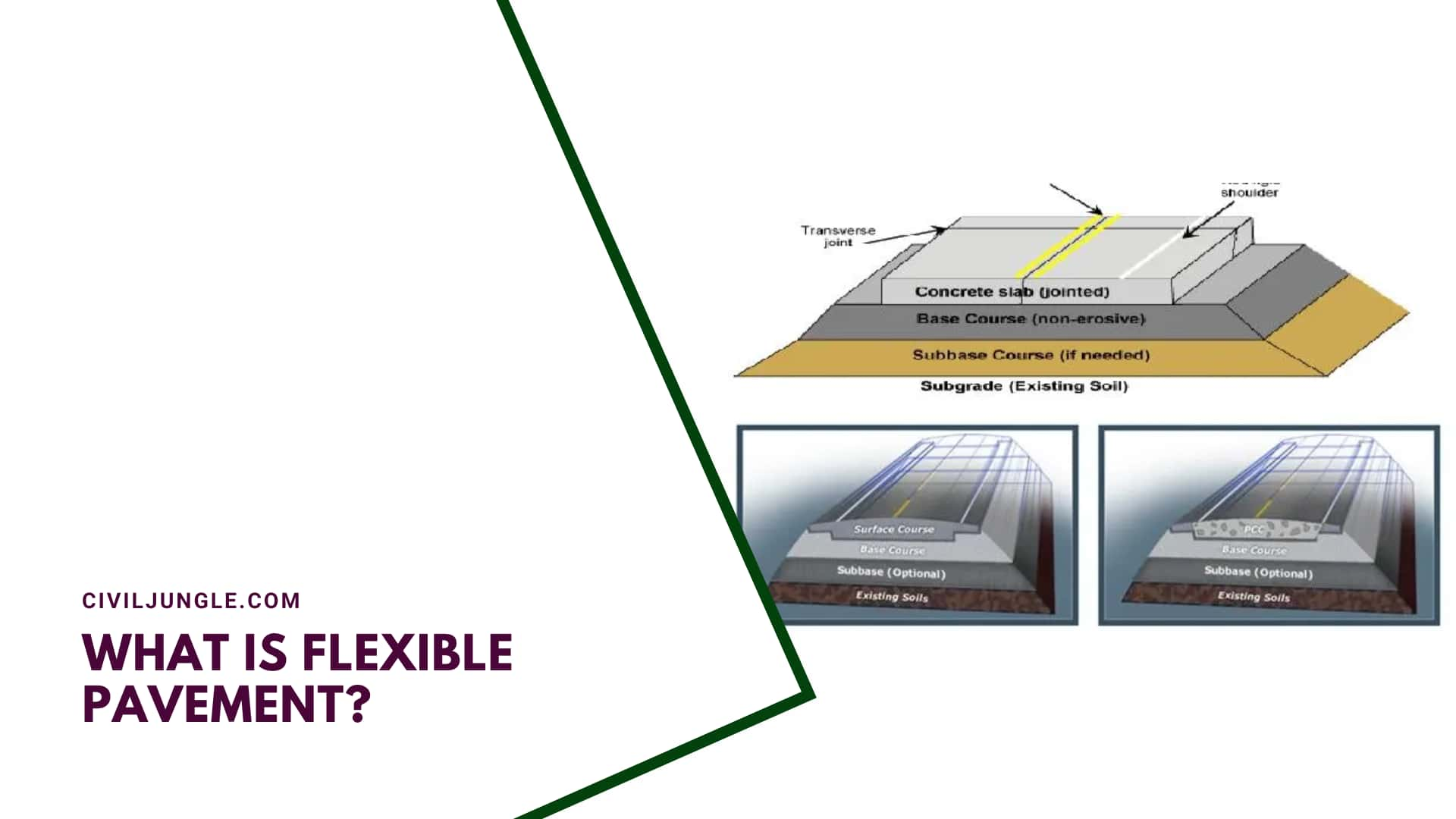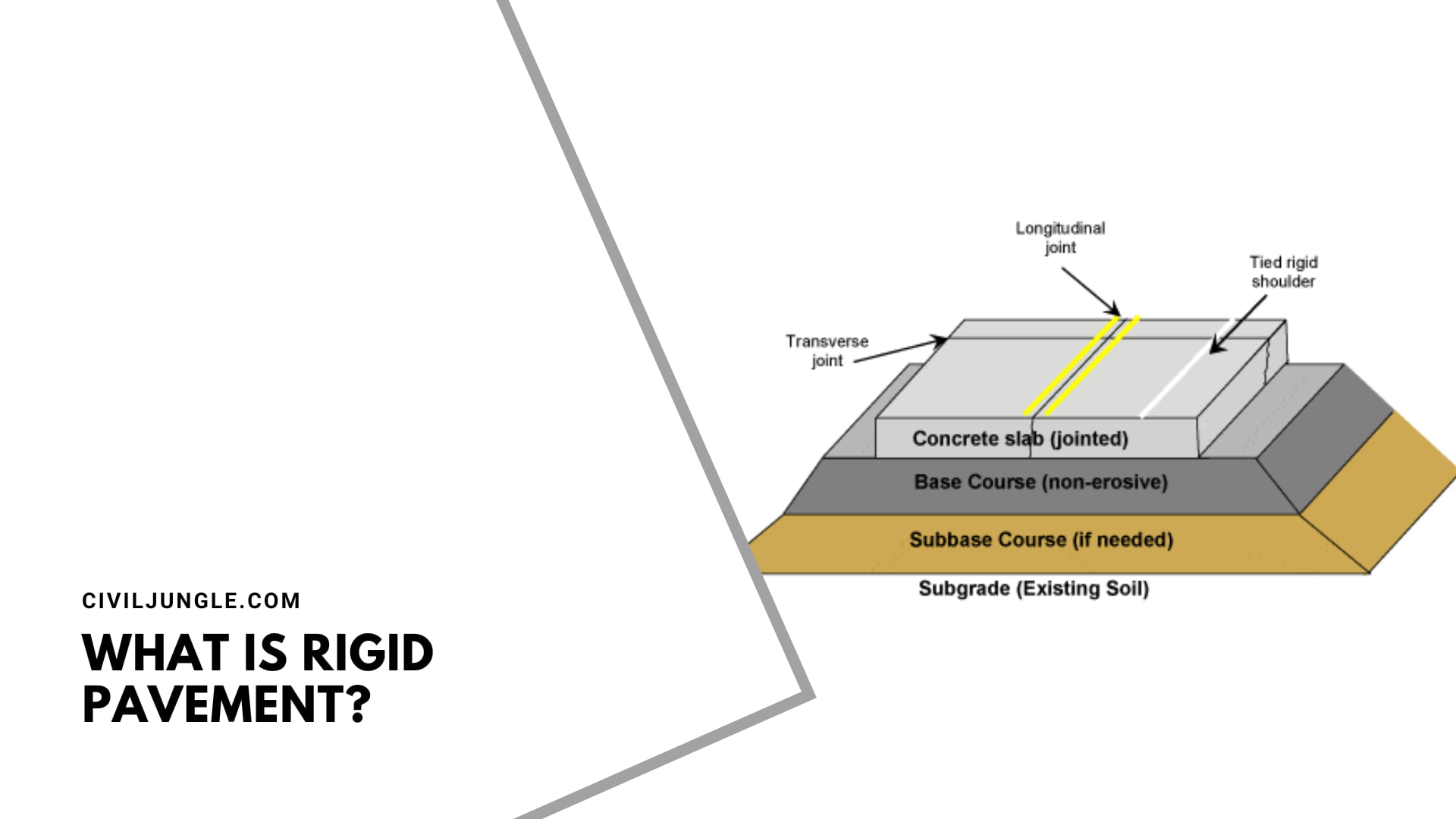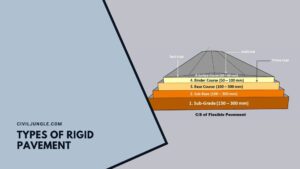
What Is Pavement?

Pavement is generally a hard surface that is made with surface materials to make it durable enough. These materials are laid on that area which is referred to carry vehicular traffic and foot traffic. The main purpose is to refer the vehicle load from the top layer to the subgrade by different layers.
The purpose of providing road pavement is to give sufficient skin resistance, proper riding quality, low noise pollution, favorable light-reflecting, etc. The main motto is to reduce the vehicular load and transmit it to the subgrade without exceeding the nearing capacity of the subgrade.
Road pavements play a very important role in any type of construction. Road pavements are generally divided into types of pavement in civil engineering, those are flexible pavement and rigid pavement.
Types of Pavement

Generally, pavements that are widely used in construction are divided into two types, those are-
1. Flexible Pavement:
In this type of pavement, also known as conventional flexible pavement, the vehicular loads are transferred by the grain-to-grain contact of the aggregates through the granular structure. This type of pavements has less structural strength by these types of pavements are widely used nowadays. (e.g. Bituminous Pavement)
2. Rigid Pavement:
In this type of pavement, the vehicular loads are transferred to the sub-soil by flexural strength. This type of pavement is acts as a rigid plate and it is generally longer lifespan and more durable. (e.g. Concrete Pavement )
There is also a type of pavement which is known as combined pavement. Another name of this type of pavement is semi-rigid pavement. In this pavement construction, a thin layer of flexible pavement is provided over the ideal pavement. Generally, this type of pavement is rarely used in construction because of high cost, and skilled labor and we need to perform complex analysis at the beginning.
What Is Flexible Pavement?

Flexible is a type of pavement that is mostly used in modern days. In inflexible pavement, the vehicular loads are transferred to sub-soil by the grain-to-grain contact of the aggregates through the granular structure. Here, the wheel loads of vehicle stresses act on the pavement, and then it’s distributed to a larger area of contact and then the stress decreases with the depth.
According to the vehicular loads; the layers of the flexible pavement are to be decided. To get the better quality of the flexible pavement we need to apply the maximum compressive stress, you can also provide low-quality material at the bottom portion.
Generally, bituminous materials are used to construct the flexible pavement and if there is some settlement then you need to consider the overall depth performance.
Types of Flexible Pavement

Generally, 3 types of pavements in road construction are divided into three types, those are following.
1. Conventional layered flexible pavement:
Conventional layered flexible pavement is a type of flexible pavement where high-quality materials are placed at the top of the pavement to resist the maximum stress that comes from vehicular loads and low-quality and cheap materials are used in the bottom part of the layers.
2. Full-depth asphalt pavement:
In full-depth asphalt pavement, also considered a type of pavement structure, we provide a total bituminous layer directly on the subsoil. This type of pavement is suitable for high-traffic areas where local materials are not available.
3. Contained rock asphalt mat (CRAM):
In this type of pavement, an open-graded or dense layer is provided in between two asphalt layers. After that asphalt concrete is placed over the sub-soil. This asphalt concrete will reduce the vertical compression of sub-grade soil and protect surface water.
Flexible Porous Pavement
Flexible porous pavement, sometimes referred to as soft pavement, is a type of pavement that is the combination of two suppliers, which are Flexi pave and porous paving. These are made with the same materials and the same process will be followed. A recycled passenger tire is used to produce porous pavement.
This type of pavement is eco-friendly and it has the capacity to purify the water of 3000 gallons/ per square foot/ hour it also cleans the water if water passes through it. Flexible porous pavement can be installed everywhere, you can also install it on soft clay.
What Is Rigid Pavement?

To define rigid pavement, it is a type of pavement that transfers the load in a wider range and it has good flexural strength. It does not have so many layers like flexible pavement because it is constructed with a single layer. The rigid pavement is directly placed over the well-compacted sub-grade granular soil or stabilized material in a single layer.
A sub-base layer is called a concrete layer which is laid between concrete and sub-grade. In the rigid pavement, the vehicular loads are transferred through the slab section and it acts like an elastic plate which is resting on a viscous medium. The rigid pavement is generally constructed by plane cement concrete.
The rigid pavement mechanisms are based on the plate theory, which states that the plane before loading is remaining the same after loading.
Types of Rigid Pavement

When it comes to the classification of pavement, rigid pavements are classified into four types, those are-”
1. Jointed Reinforced Concrete Pavement (JRCP):

In rigid pavement, reinforcement is always provided to provide more structural stability. It can increase the spacing by 10 to 30 m. Here, dowel bars are provided to carry loads and reinforcement prevents cracks.
2. Jointed Plain Concrete Pavement (JPCP):

This type of pavement is constructed with plane cement concrete which has closely spaced construction joints. Here, dowel bars are placed to carry the loads and the joint spacing is near about 5 to 10 m.
3. Continuous Reinforced Concrete Pavement (CRCP):

Continuous reinforced concrete pavement is a type of pavement where no joint is to be provided.
4. Pre-Stressed Concrete Pavement:

It is a type of pavement where the pre-cast slab is placed on the subsoil. It is a costly type of pavement and it requires more skilled labor and high accuracy.
Road Pavement Layers
When discussing types of pavement materials, there are generally eight types of layers present, which are-
1. Compacted sub-grade (150-300 mm):
In all pavement layers, the Compacted sub-grade layer is the bottom-most layer. It must be properly compacted to reach its final density and optimum moisture content.
2. Sub-base course (100-300 mm):
It is one of the base courses which plays a major role in providing structural support. The sub-base course is made with more fine materials.
3. Base course (100-300 mm):
It is placed just below the surface of the binder course which provides additional load distribution capacity and sub-surface drainage. It is made with some crushed slag or stabilized materials.
4. Prime coat:
A prime coat is a cutback bitumen that is used to bind two layers.
5. Binder coat (50-100 mm):
A binder coat is basically a bilk asphalt concrete that is provided for binding purposes.
6. Tack coat:
A tack coat is basically an asphalt coating that is used for the binding purpose between two layers.
7. Surface course (25-50 mm):
It is the course that carries the direct vehicular loads and we provide the best quality materials at this layer. It is generally constructed with asphalt concrete.
8. Seal coat:
A seal coat is a waterproof coating that is provided on the upper portion of the pavement at the end of the construction.
Frequently Asked Questions (FAQ)
What Is Pavement?
Pavement is a hard surface made from various materials designed to withstand vehicular and foot traffic. It distributes the load from the top layer to the subgrade through multiple layers to ensure durability and performance.
What Are the Main Types of Pavement?
The two main types of pavement are:
- Flexible Pavement: Transfers vehicular loads through the granular structure and distributes stress to the subgrade.
- Rigid Pavement: Transfers loads through flexural strength and is generally constructed with a single concrete layer.
What Is Flexible Pavement and How Does It Work?
Flexible pavement uses a layered structure where the loads are transferred through grain-to-grain contact of aggregates. The stress from wheel loads is distributed across a larger area, and it decreases with depth. It is typically constructed with bituminous materials.
What Types of Flexible Pavements Are Commonly Used?
Common types include:
- Conventional Layered Flexible Pavement: High-quality materials on top and lower-quality materials below.
- Full-Depth Asphalt Pavement: A continuous bituminous layer over the subgrade.
- Contained Rock Asphalt Mat (CRAM): A layer of open-graded or dense material between two asphalt layers.
What Is Rigid Pavement and How Does It Differ from Flexible Pavement?
Rigid pavement uses a single layer of concrete that acts as a rigid plate, distributing loads over a wider area through flexural strength. It generally has a longer lifespan and is more durable compared to flexible pavement.
What Types of Rigid Pavements Are There?
Types of rigid pavements include:
- Jointed Reinforced Concrete Pavement (JRCP): Features reinforcement for added stability and load-carrying capacity.
- Jointed Plain Concrete Pavement (JPCP): Constructed with plain cement concrete and closely spaced joints.
- Continuous Reinforced Concrete Pavement (CRCP): Does not include joints and is continuously reinforced.
- Pre-Stressed Concrete Pavement: Uses pre-cast slabs and requires skilled labor for installation.
What Are the Different Layers of Road Pavement?
The typical layers of road pavement include:
- Compacted Sub-grade: The bottom layer, providing the foundation.
- Sub-base Course: Provides structural support with finer materials.
- Base Course: Supports load distribution and sub-surface drainage.
- Prime Coat: Binds underlying layers with cutback bitumen.
- Binder Coat: Binds the base and surface layers with bulk asphalt concrete.
- Tack Coat: Adhesive layer between two pavement layers.
- Surface Course: The top layer that directly supports traffic.
- Seal Coat: A waterproof coating applied to the surface layer for protection.
What Is Flexible Porous Pavement and Its Benefits?
Flexible porous pavement combines materials like recycled tires to create a permeable surface that allows water to pass through. It is eco-friendly, can purify water, and can be installed on various soil types, including soft clay.

